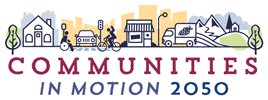Where the Rubber Meets the Road
Identifying, planning for, and funding priority projects is the ultimate purpose of a long-range transportation plan.
Funding priority projects is truly where the rubber meets the road…whether that “rubber” is on a bike, car, truck, bus tire, or your favorite sneakers.

Priority Projects
COMPASS has identified a combination of funded and unfunded priority projects across multiple transportation modes to help meet the transportation needs of all users to the year 2050:
-
Short-term budgeted projects (funded between 2022 and 2026)
-
Prioritized state and local system roadway projects (needed by 2030; funded and unfunded)
-
Long-term funded projects (anticipated funded between 2027 and 2050)
-
Prioritized unfunded public transportation system projects
-
Unfunded regional priority pathways
-
Unfunded roadway projects (needed beyond 2030)
-
Unfunded studies
Where did these projects come from?
The projects in these different categories are more than simply a wish list. Each was identified and vetted through a rigorous process.
| Short-term budgeted and long-term funded projects | Identified as “funded” in the previous long-range transportation plan (Communities in Motion 2040 2.0), the regional transportation improvement program (TIP), and/or by local jurisdictions in their own transportation plans. |
| Prioritized roadway projects needed by 2030 | Identified using COMPASS’ “travel demand forecast model” as being needed by 2030 to help address increased traffic due to growth. Those projects – a combination of funded and unfunded – then were run through additional meticulous analysis to determine how well each will help meet CIM 2050 goals and transportation demand, then prioritized based on that analysis. These projects are further divided into “state” and “local” roadway priority lists, to reflect funding allocation. |
| Unfunded public transportation and pathway projects | Identified and prioritized by the Public and Active Transportation Workgroups, respectively, based on a series of criteria. Public transportation projects are divided into sub-priorities, while pathway projects represent the highest priority projects, but are not ranked. |
| Unfunded roadway projects beyond 2030 and studies | Identified as needed by 2050, but not further prioritized. |
Why do the priorities matter?
COMPASS and its members will use the identified priorities to guide funding decisions, including allocating federal funding, per the CIM 2050 funding policy, and seeking additional funding through competitive grants. COMPASS will focus its efforts on funding projects on these priority lists, and on the highest-priority projects within the lists as identified.
Federally funded and regionally significant projects will be budgeted through COMPASS’ regional transportation improvement program.


